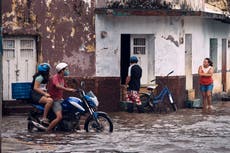Trump falsely said the Green New Deal requires ‘tiny little windows’. What does it actually say?
The proposal to tackle the climate crisis was introduced last year by progressive Democrats Alexandria Ocasio-Cortez and Ed Markey
Donald Trump falsely claimed that the Green New Deal would require “tiny little windows", during a rambling interview with Fox News host Sean Hannity on Thursday.
“I mean, they literally want to take buildings down and rebuild them with tiny little windows, OK, little windows, so you can't see out, you can't see the light,” the president said.
America, he continued, “will be a ninth world country, not a third world country, a ninth world country. We won't have energies. Look at what's happening with the rolling blackouts in California. Look at where California is going to have to ration water.”
Windows are not mentioned in the Green New Deal (GND), the 14-page bill aimed at simultaneously tackling the climate crisis and providing jobs. It was introduced in 2019 by progressive Democrats Representative Alexandria Ocasio-Cortez and Senator Ed Markey.
Instead, the proposal calls for “upgrading all existing buildings” in the US, and that any new ones “achieve maximum energy efficiency, water efficiency, safety, affordability, comfort, and durability, including through electrification”.
Mr Trump’s “little windows” is not the first wild claim about the GND that has emerged in Republican talking points.
“They want to take away your hamburgers,” Sebastian Gorka, a former Trump adviser, claimed last year.
Senate majority leader Mitch McConnell dubbed it “garden-variety 20th-century socialism” while Utah congressman Rob Bishop called the proposal “tantamount to genocide” for rural America.
Hysteria aside, the GND - which takes its name from President Franklin D Roosevelt’s vast public works programmes that helped turn around America’s fortunes following the Great Depression in the early 1930s - calls for a decade of national mobilisation to pivot the economy from fossil fuels to renewable energy, like wind and solar.
Among other ideas, the GND includes plans for:
- A public infrastructure overhaul: repairing, upgrading, expanding of roads, railways, bridges, energy grids and water systems in a way that cuts pollution, providing jobs along with way
- Part of that infrastructure revamp would be replacing lead pipes to ensure clean water, and build-outs of green infrastructure so cities can better handle stormwater
- It also calls for a high-speed rail network across the US and expanding light rail and clean buses in cities to cut emissions and air pollution
- “Smart grid” development which will create jobs and at the same time, clean power
- A “Green Brigade” - creating employment for thousands of people in restoring ecosystems that help fight the climate crisis, including jobs in forest growth and fire safety, revitalising wetlands and parks, and the safe clean-up of hazardous waste
- Priority would be given to projects that benefit low-income families and communities of colour to address historic economic inequity.
In its current form, the GND is a non-binding resolution and does not contain details on how it will be financed.
Democratic presidential candidate Joe Biden, however, has his own climate agenda which calls for a $2 trillion investment in clean energy over four years. Senior campaign officials told the AP in July that it would require a mix of tax increases on corporations and the wealthy and deficit spending aimed at stimulating the economy.
The AP contributed to this report



Join our commenting forum
Join thought-provoking conversations, follow other Independent readers and see their replies
Comments